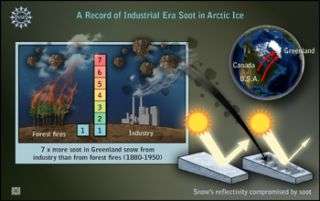Arctic climate study reveals impact of industrial soot

Scientists from the Desert Research Institute (DRI) and their collaborators have determined that Northern Hemisphere industrial pollution resulted in a seven-fold increase in black carbon (soot) in Arctic snow during the late 19th and early 20th centuries, according to new research into the impact of black carbon on Arctic climate forcing.
The study in the August 9th online edition of Science magazine was led by Drs. Joe McConnell and Ross Edwards – two ice core scientists from DRI – who used a new method for measuring soot in snow and ice to evaluate historical changes in soot concentrations using an ice core from the Greenland Ice Sheet. At its maximum from 1906 to 1910, estimated early summer surface climate forcing from black carbon in Arctic snow was eight times that of the pre-industrial era.
Soot reduces reflectivity of snow and ice — decreasing its albedo in scientific terms — allowing the surface to absorb more energy from the sun. Changes in highly reflective seasonal snow covers may have resulted in earlier snow melt and exposure of much darker underlying soil, rock, and sea ice throughout the Arctic — leading to warming across much of this region in the late 19th and early 20th centuries. For the Greenland ice sheet, these findings are significant because it is the largest ice mass in the northern hemisphere and darkening of the surface by soot from combustion of biomass and fossil fuels accelerates melting and increases sensitivity to warming.
In an article published in the August 9th online edition of Science magazine, a team of National Science Foundation- and NASA-funded researchers from DRI, the University of California, the University of Wisconsin, and Droplet Measurement Technologies report results of this novel ice-core analysis and modeling effort. Their measurements of deposition during the past two centuries, combined with modeling, reveal that the source of most of the black carbon landing on the ice changed from natural causes such as forest fires to industrial sources. The amount of black carbon deposited during this period increased precipitously, reaching a peak around 1910.
“Concentrations of black carbon varied significantly from 1788 to 2002 and were highly seasonal, particularly during the period before the Industrial Revolution in North America in the mid-1800s,” said lead author Joe McConnell. “Starting in about 1850, soot concentrations began to rise, particularly in winter when forest fire emissions are at a minimum,” McConnell added.
“In addition to black carbon, we measured a broad range of other chemicals at very high depth resolution in this same ice core,” said Joe McConnell. “Two of these ancillary measurements, vanillic acid and sulfur, are indicators of forest fire and industrial emissions, respectively. When we compare changes in the black carbon to changes in these other indicators, it is clear that most of the increases in black carbon in the late 19th and early 20th centuries, particularly in winter and spring, resulted from industrial emissions - probably from coal burning.”
Co-author Ross Edwards added, “In order to understand why Arctic climate is changing so rapidly at present, we need to understand how and why it has changed both before and after human activities had an influence on climate. To do this properly, we need to know the seasonal history of soot deposition and its impact on Arctic snow albedo during the past few centuries. Our results allow this component of climate change to be incorporated into predictive climate models in a more realistic way.”
By tracking the possible trajectories of major snowfall events that would have transported and deposited the black carbon to largely undeveloped Greenland, the researchers conclude that industrial areas of the United States and Canada were the most likely sources of the increased deposition during the past century. Boreal forest fires in northern and eastern Canada and the United States were the likely sources of natural black carbon found in the ice core.
“We used computer models to simulate the climate forcing impact of the observed changes in soot concentrations in Greenland snow during the past 215 years,” said co-author Mark Flanner from the University of California and now at the National Center for Atmospheric Research. Simulations also were used to extend the climate forcing results from central Greenland to the entire Arctic based on regional-scale models. From these simulations, the average impact from soot pollution over the Arctic was about double that found for central Greenland. Early summer climate forcing throughout the Arctic during and after industrialization was substantial, with changes largely attributed to winter-time pollution. In the peak period from 1906 to 1910, the warming effect of the industrial soot throughout the Arctic was estimated at eight times that during the pre-industrial period.
Source: Desert Research Institute




















